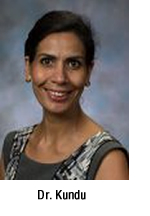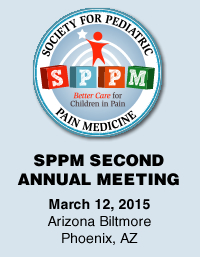From the Ancient to the Modern……
 By Anjana Kundu, MBBS, DA
By Anjana Kundu, MBBS, DA
Nationwide Children’s Hospital
Columbus, OH
As I am writing, the snow is falling outside, and the eastern United States is bracing for a historic winter storm. To those of you in northern climates, I hope you are taking the winter in stride. To those of you in southern climates, enjoy your good fortune!
Bringing you the third edition of the newsletter for the Society for Pediatric Pain Medicine is especially exciting for me. It allows me to share with you the incredible expanse we find in the art of healing, ranging from the wisdom of ancient traditions to the latest and greatest advances in science and technology, all brought to bear for healthcare. Growing up in India, the land of the ancient healing system of Ayurveda, I was taught to respect the seasonal changes in dietary intake, “hot” and “cold” qualities of food, innate healing abilities of our bodies, foods and herbs as medicine. Ayurveda literally means “science of life” (Ayur - life, Veda - science or knowledge). It is an ancient health system with its origins dating as far back as 5000 BC during the Indus Valley civilization. Providing guidelines on ideal daily and seasonal routines, nutrition, herbs, behavior and the proper use of our senses (meditation), physical activity (Yoga) and manual therapies (massage), Ayurveda fosters the belief that health is the balanced and dynamic integration between our environment, body, mind, and spirit. This is especially pertinent to the practice of pain management, which is such a multifaceted entity.
As a child I could never make sense of these rituals and “home remedies.” Perhaps this was the biggest driving force in my pursuit of medicine as a career; in order to find the scientific validity of health practices. In my pursuit for answers about the “hows” and “whys” of medicine, I came up with more questions. However, this journey has also led me to relinquish the use of a black and white lens when considering the complex interplay of forces that drive the wellness of a human body. Today I find myself embracing the wisdom of ancient therapies such as acupuncture, massage, mind-body medicine, and dietary alterations, hand in hand with modern medical miracles including medications, nerve blocks and implantable devices to optimize the outcomes for my patients. I greatly appreciate the availability of technology at our fingertips such as smart phone apps that can remind us to drink water, to do breathing exercises, to provide guided relaxation strategies, a 5 minute work-out, and the list goes on.
In this edition of the SPPM newsletter we feature articles from the ancient to the most modern. We see how the multidimensional nature of pain management can encompass modalities and treatments that span the ages.
Dr. Haleh Saadat brings us an article that explores the use of an age-old mind body medicine practice in medical and surgical treatments, hypnosis. Despite its ancient origins, hypnosis remains a powerful and vital tool in treating pediatric pain. Dr. Mark Thompson explores the reemergence of thoracic Paravertebral nerve block for perioperative analgesia. Dr. James Mooney explores cutting edge uses of technology in medicine, focusing on the use of 3D printing. Today, scientists and physicians have been able to use a 3D printed trachea for infants with laryngotracheomalacia and limbs for amputees. As clinicians, keeping up with technology can be a constant challenge, but it also affords amazing new opportunities for not only treatments, but also education for our trainees in a revolutionary, simulated environment.
I hope you enjoy this edition of the SPPM Newsletter, and look forward to the warmth of Arizona in March.
The SPPM is off to a running start, and the momentum is growing. I’m honored to be part of this movement. It will be a pleasure to see everyone in Phoenix, AZ for the SPPM 2nd Annual Meeting in March.

